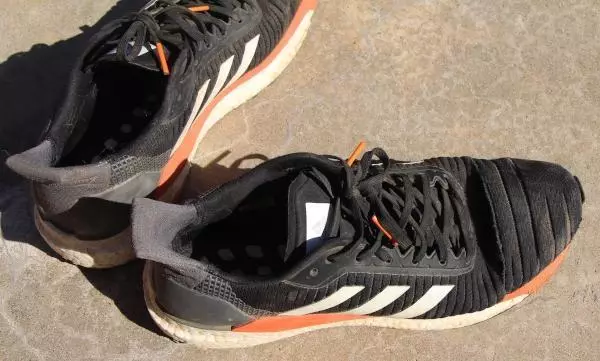 Adidas Solar Glide - Image Source: shopmrkatin.vn
Adidas Solar Glide - Image Source: shopmrkatin.vn
When it comes to running shoes, Adidas is a brand that always sparks interest. The Adidas Solar Glide is no exception. Known for its responsive and comfortable design, this shoe has garnered attention from runners worldwide. However, after putting the Solar Glide to the test, I discovered some pros and cons that deserve a closer look.
A Tear in the Upper
After running 300 miles on the road and 40 miles on the trails, I was disappointed to find that the upper of my right shoe had torn in half. While I can't pinpoint the exact cause, I doubt it was due to any external force. What's more concerning is that a parallel tear began further down the toe. This tearing issue is something I have never experienced before with any other shoe.
Comparing to Other Adidas Models
Having previously trained and completed a marathon in the Adidas Ultraboost, I couldn't help but compare the Solar Glide to its predecessor. Although the Solar Glide feels lighter, it lacks the stability I found in the Ultraboost. As I continued running with the Solar Glide, I started experiencing knee pain, which required the use of insoles for relief. While the insoles helped, they added significant weight to the shoe. This was not an issue I encountered with the Ultraboost or the Boston model.
Furthermore, my half marathon time in the Solar Glides was noticeably slower compared to the Boston model. The Solar Glides, although consistent and responsive, lacked the speed and motivation that the Boston model provided. While I still rank the Solar Glides as a decent trainer for longer runs, I wouldn't recommend them for racing or tempo runs.
Embracing the Adiboost Midsole
One of the main reasons I purchased the Solar Glides was for the adiboost midsole. This technology offers unparalleled responsiveness and enhances the overall running experience. I immediately noticed a boost in speed when switching to the Solar Glide from my Brooks Ravenna. However, it's worth noting that the older version of the Solar Glides had issues with the stretchable heel fabric falling apart. Thankfully, this problem has been resolved in the newer model.
Traction and Durability
The Continental outsole of the Solar Glide provides reliable grip, even on wet pavement and slushy conditions. However, I did experience some traction issues on mountain trails, especially while descending on steep, rocky terrain. Nonetheless, the shoes held up well during trail runs with significant elevation gain, and the upper provided ample breathability without compromising on toe protection.
Comfort and Fit
In terms of fit, the Solar Glides perform admirably. The heel feels secure without being overly tight, and the toe box offers a form-fitting experience. The material is stretchable enough to accommodate wider feet comfortably. However, individuals with wide feet may still face challenges, as the footbed is not as wide as desired. This resulted in small blisters on the inside of both feet, a common issue I've encountered with many shoes.
Final Verdict
While the Adidas Solar Glide has its fair share of drawbacks, it remains a reliable trainer option for longer runs and casual training sessions. The adiboost midsole provides an energetic ride, and the shoe offers a comfortable fit for most runners. However, the tearing issue in the upper and the narrow footbed may deter some individuals. Ultimately, it's essential to consider your specific needs and preferences before making a purchasing decision.
 Adidas Solar Glide After 300 Miles - Image Source: shopmrkatin.vn
Adidas Solar Glide After 300 Miles - Image Source: shopmrkatin.vn

















